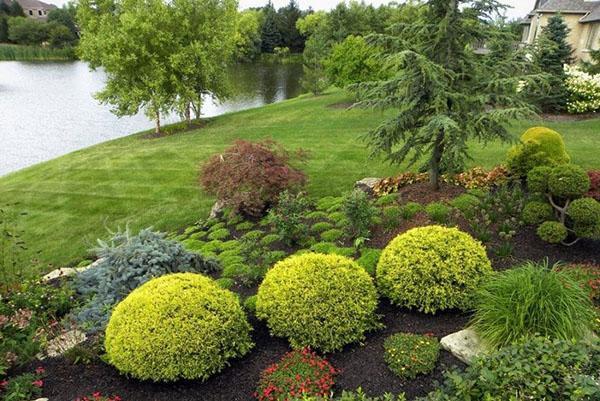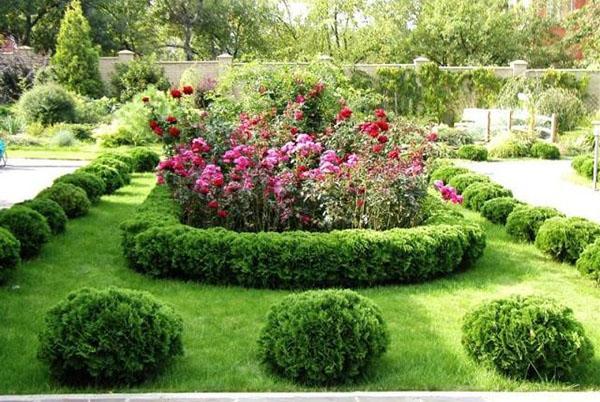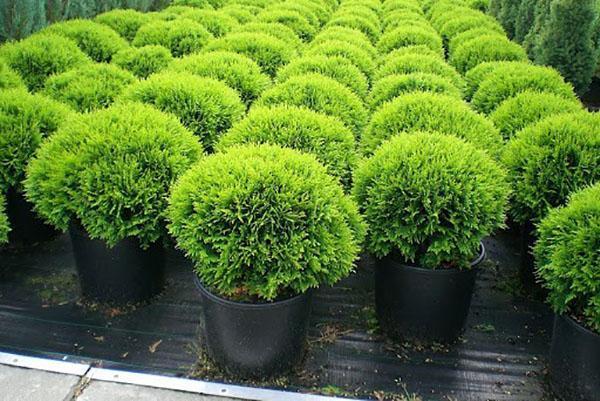The highlight of the garden: thuja with a spherical crown shape
 Thuja globular is a frequent visitor to the gardens. The size of this plant can vary from several tens of centimeters to one and a half meters. The color of the crown also differs in different varieties.
Thuja globular is a frequent visitor to the gardens. The size of this plant can vary from several tens of centimeters to one and a half meters. The color of the crown also differs in different varieties.
Growing this decorative tree is not easy. Only the correct fit and care of the spherical thuja will provide it with a healthy dense crown and a spectacular rounded shape.
Species affiliation

- Thuja western spherical unpretentious and suitable for growing in our country.
- The varietal variety of this species is so great that you can choose a suitable option from the available varieties. In addition, the selection of new varieties continues to this day.
Spherical forms are found among other types of thuja (Japanese, Korean and others), but these varieties are difficult to grow in our climatic conditions outdoors. Further recommendations for care relate specifically to the globular varieties of western thuja.
Planting and leaving
 Proper planting and caring for a spherical thuja in the garden are prerequisites for the good development of the tree.
Proper planting and caring for a spherical thuja in the garden are prerequisites for the good development of the tree.
When and where to plant?
When choosing a landing site, give preference to partial shade. In the shade, the plant will lose its decorative qualities, the crown will become rare, and the branches will stretch out. In areas with short daylight hours, spherical thuja can be planted in a well-lit place, but in the steppe zone, direct sunlight and low humidity will lead to sunburn and shedding of needles. Also, the plant has a negative attitude towards drafts, so the planting site must be protected from the wind.
Thuja is unpretentious to the soil, but the best result can be achieved on fertile, moderately moist soils. In places where groundwater is high. In the lowlands of beams and on loams, a drainage layer up to 20 cm thick is laid at the bottom of the planting pit.
The plant enters the active growing season in May, so it can be transplanted in early spring or autumn. The pit is prepared 2 weeks before planting, moistened and filled with a soil mixture: turf + peat + sand (2: 1: 1). The composition for transplantation can be additionally enriched with nitroammophos.
Plants are transplanted, which have reached the age of 5-7 years, together with the root ball. Below in the photo is a spherical thuja, prepared for transplantation.
The root collar is not buried; it should be at the level of the soil surface. After planting, the seedlings are watered daily for a month (1 bucket of water for each tree). The first year after planting, the plant is sensitive to direct sunlight, so it is shaded with kraft paper, cloth or sunscreen.
Watering and loosening
Thuja with a spherical crown shape is resistant to short-term drought, but if the plant grows for a long time in conditions of water shortage, its crown thins. After a month after planting, young seedlings are watered once a week (10 liters for each plant). In a dry season, the number of waterings should be increased to 2 times a week.
So that the roots of the plant "breathe", after each watering, the soil is loosened to a depth of 10 cm and mulch peat, shavings or compost. The thickness of the mulch layer must be at least 7 cm.
Preparing for winter
Adult plants tolerate even frosty winters well, while young plants should be covered with spruce branches, fallen leaves or special agromaterials in late autumn. When the air temperature drops to -5aboutC, the plant is additionally wrapped in foil.
Pruning
The breeders took care of the preservation of the spherical shape of the crown, so there is no need to additionally form the plant. Every spring, they carry out sanitary pruning, removing dead and diseased branches. In spring and at the end of summer, thuja are cut, which are used as a hedge.
Thanks to its dense crown, the tree lends itself well to decorative molding. An experienced gardener is able to give it different shapes.
Top dressing
Tui is classified as a slow-growing tree, therefore fertilizers must be entered carefully. The first 3 years of life after transplanting top dressing are not recommended. In subsequent years of life, the amount of fertilizer applied depends on the growth rate of the tree: less for dwarf varieties, more for tall ones.
Experts are skeptical about the application of organic fertilizers for conifers. It is better to use commercially available complex fertilizers for thuja.
Reproduction
At home, thuja are propagated by cuttings. It is carried out in the fall after the end of the growing season or in the spring before bud break. For planting, cuttings from 50 cm in length with a well-formed "heel" are used. In the lower part of the cutting, the needles are cut and treated with one of the root-forming compounds.
A special soil mixture is prepared for planting: turf soil (1 part) + sand (1 part) + peat (1 part). The stalk is immersed in a moistened mixture for 3 cm and covered with foil to maintain the moisture level. If cuttings are carried out in the fall, you need to take care of good lighting of the seedlings. Spring landings, on the other hand, shade.
Varieties
The varietal variety of thuja with a spherical crown is great. Trees differ in both size and color. Below are photos of the varieties and types of spherical thuja that are most widespread, as well as their description.
 Globoza is a tall variety, the height of adult plants reaches 1.2-1.5 meters. The color of the needles changes depending on the season: in summer it is green, in winter it is brown. Plants of this variety do not require molding - by the age of 5-7 years, the trees become spherical, further growth is 5 cm in height and width annually, and the crown becomes thicker with age.
Globoza is a tall variety, the height of adult plants reaches 1.2-1.5 meters. The color of the needles changes depending on the season: in summer it is green, in winter it is brown. Plants of this variety do not require molding - by the age of 5-7 years, the trees become spherical, further growth is 5 cm in height and width annually, and the crown becomes thicker with age.
 Thuja globular Danica is a low-growing variety (the height of mature trees is up to 80 cm). It gained popularity due to its unpretentiousness, winter hardiness and the ability to maintain shape without pruning.
Thuja globular Danica is a low-growing variety (the height of mature trees is up to 80 cm). It gained popularity due to its unpretentiousness, winter hardiness and the ability to maintain shape without pruning.
 The Reingold variety has a high decorative effect. The main feature of this tall plant (up to 1.5 m) is the unusual color of the needles: pinkish in spring, light golden in summer, and copper-yellow, almost brown in autumn.
The Reingold variety has a high decorative effect. The main feature of this tall plant (up to 1.5 m) is the unusual color of the needles: pinkish in spring, light golden in summer, and copper-yellow, almost brown in autumn.
 One of the novelties of the selection is the dwarf spherical thuja of the Teddy variety. The height of this unusually dense shrub reaches 30 cm, while the needles that are atypical for thuja are remembered: smooth, rich green and not prickly. The plant is resistant to sunburn and does not lose its decorative effect for a long time.
One of the novelties of the selection is the dwarf spherical thuja of the Teddy variety. The height of this unusually dense shrub reaches 30 cm, while the needles that are atypical for thuja are remembered: smooth, rich green and not prickly. The plant is resistant to sunburn and does not lose its decorative effect for a long time.
Application in landscape design
 Thuja globular found wide application in landscape design. These versatile trees go well with other plants and decorative items. Due to the slow growth, compositions with thuja retain their original appearance for a long time, therefore they are often used in mixborders, rock gardens and Japanese gardens.
Thuja globular found wide application in landscape design. These versatile trees go well with other plants and decorative items. Due to the slow growth, compositions with thuja retain their original appearance for a long time, therefore they are often used in mixborders, rock gardens and Japanese gardens.
Dwarf varieties grow well in containers and pots, with their help you can create a kind of coniferous lawn. As curbs or hedges, you can use a medium-sized variety of spherical thuja.